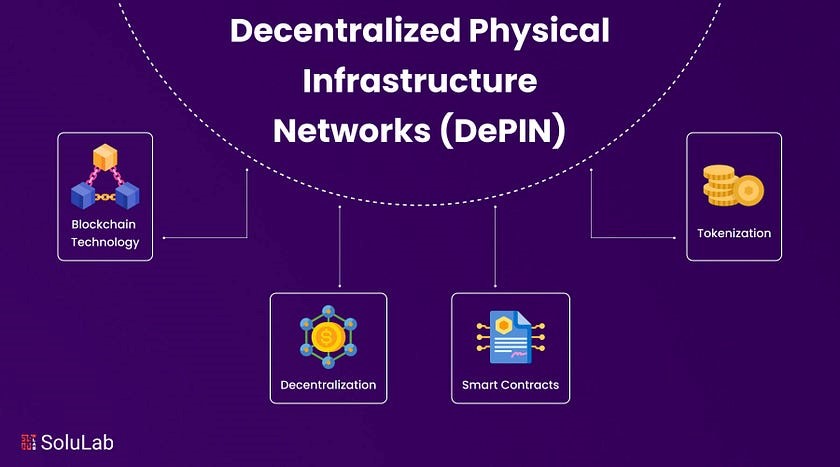A Comprehensive Guide to Decentralized Physical Infrastructure Networks (DePIN)
分散型物理インフラ・ネットワーク(DePIN)の包括的ガイド

SoluLab
ソルラボ
Published in Predict
予測に掲載
May 14, 2024
2024 年 5 月 14 日
The rise of blockchain technology in recent years has caused a dramatic change in how we see and engage with digital systems. The concept of decentralization has altered many facets of our online existence, beginning with decentralized finance (DeFi) and continuing with non-fungible tokens (NFTs). Still, this metamorphosis is not exclusive to the internet.
近年のブロックチェーン技術の台頭により、デジタルシステムの見方や関わり方に劇的な変化が生じています。分散化の概念は、分散型金融(DeFi)から始まり、非代替性トークン(NFT)に至るまで、私たちのオンライン存在の多くの側面を変えました。しかし、この変容はインターネットに限ったことではありません。
A novel idea known as “decentralized physical infrastructure networks,” or “DePINs,” pushes the boundaries of decentralization to encompass actual physical buildings. DePINs have the potential to revolutionize several sectors and empower individuals to take charge of their own lives.
「分散型物理インフラ・ネットワーク」または「DePIN」として知られる斬新なアイデアは、分散化の境界を押し広げ、実際の物理的な構築を包含します。DePINは、いくつかのセクターに革命をもたらし、個人が自分の生活に責任を持つ力を与える可能性を秘めています。
In this blog, we will explore the fundamentals of DePIN, its importance, and its possible effects on several industries.
このブログでは、DePINの基礎、その重要性、およびいくつかの業界に起こりうる影響について説明します。
What Exactly is DePIN?
DePINとは一体何か
Large firms have traditionally been in charge of setting up and managing physical infrastructure, such as electricity grids, water and waste management systems, cloud computing, and public infrastructure upkeep. Large-scale projects need significant capital inputs and logistical challenges, which contribute significantly to their dominance. As a result, these centralized companies frequently control the market, having an impact on customer choice and price for a variety of services. This control frequently results in less innovation and competition, which lowers the quality of the overall customer experience.
従来、大企業は、電力網、水道および廃棄物管理システム、クラウドコンピューティング、公共インフラの維持管理など、物理的なインフラストラクチャの設定と管理を担当してきました。大規模プロジェクトには、多額の資本投入と物流上の課題が必要であり、それがその優位性に大きく貢献しています。その結果、これらの中央集権的な企業は頻繁に市場を支配し、さまざまなサービスの顧客の選択と価格に影響を与えています。この制御により、革新や競争が減少することが多く、全体的な顧客体験の品質が低下します。
Decentralized Physical Infrastructure Networks, or DePINs, are an innovative way of creating and maintaining physical infrastructure using decentralized processes that are frequently made possible by blockchain technology. This idea reimagines the financing, construction, and upkeep of infrastructure, including electricity grids, transportation networks, water supply networks, and other vital services.
分散型物理インフラ・ネットワーク(DePIN)は、ブロックチェーン技術によって頻繁に可能になる分散型プロセスを使用して物理インフラを創造および維持する革新的な方法です。このアイデアは、電力網、交通網、給水網、その他の重要なサービスを含むインフラストラクチャの資金調達、建設、維持を再考します。
How Cryptocurrency DePINs Work?
暗号通貨のDePINの仕組みは?
DePINs utilize cryptocurrency tokens to incentivize providers of decentralized physical infrastructure to join their networks. The influx of investor funds increases the value of a DePIN’s token, enabling service providers to offer competitive pricing. This leads to increased demand for and acceptance of DePIN’s services, further raising the token price. DePIN network platforms offer financial services without traditional financial institutions and may use tokenization to connect with real-world assets.
DePINは、暗号通貨トークンを利用して、分散型物理インフラのプロバイダーにネットワークへの参加を促します。投資家の資金の流入により、DePINのトークンの価値が高まり、サービスプロバイダーは競争力のある価格を提供できるようになります。これにより、DePINのサービスに対する需要と受け入れが増加し、トークンの価格がさらに上昇します。DePINネットワークプラットフォームは、従来の金融機関を使用せずに金融サービスを提供し、トークン化を使用して現実世界資産と接続する場合があります。
Types of DePINS
DePINの種類
DePINs, or Device Personal Identification Numbers, can take various forms depending on the device and its purpose. Here are some common types:
DePIN(デバイス個人識別番号)は、デバイスとその目的に応じてさまざまな形式をとることができます。一般的なタイプは次のとおりです。
Physical Resource Networks (PRNs) and Digital Resource Networks (DRNs) are both frameworks used to manage and optimize resources, but they operate in different domains:
物理リソースネットワーク(PRN)とデジタルリソースネットワーク(DRN)は、どちらもリソースの管理と最適化に使用されるフレームワークですが、異なる領域で動作します。
Physical Resource Networks (PRNs)
物理リソースネットワーク(PRN)
l PRNs deal with tangible, physical resources such as raw materials, equipment, transportation, and facilities.
PRNは、原材料、設備、輸送、施設などの有形の物理的資源を扱います。
l They focus on optimizing the flow of physical resources through supply chains, manufacturing processes, and distribution networks.
彼らは、サプライチェーン、製造プロセス、および流通ネットワークを通じた物理的リソースの流れを最適化することに焦点を当てています。
l PRNs may involve logistics management, inventory control, production planning, and transportation optimization to ensure efficient utilization of physical resources.
PRNには、物流管理、在庫管理、生産計画、および物理的資源の効率的な利用を確保するための輸送最適化が含まれる場合があります。
l Examples include traditional manufacturing industries, transportation and logistics companies, and supply chain management systems.
例としては、従来の製造業、輸送および物流会社、SCMシステムなどがあります。
Digital Resource Networks (DRNs)
デジタルリソースネットワーク(DRN)
l DRNs, on the other hand, deal with intangible, digital resources such as data, information, software, and digital services.
一方、DRNは、データ、情報、ソフトウェア、デジタルサービスなどの無形のデジタルリソースを扱います。
l They focus on managing the flow of digital resources across digital platforms, networks, and systems.
彼らは、デジタルプラットフォーム、ネットワーク、およびシステム全体のデジタルリソースの流れを管理することに焦点を当てています。
l DRNs involve processes such as data management, information sharing, digital collaboration, and software development.
DRNには、データ管理、情報共有、デジタル協働、ソフトウェア開発などのプロセスが含まれます。
l Examples include digital platforms like social media networks, cloud computing services, digital marketplaces, and online collaboration tools.
例としては、ソーシャル メディア ネットワーク、クラウド コンピューティング サービス、デジタル市場、オンライン協働 ツールなどのデジタル プラットフォームが含まれます。
While both PRNs and DRNs involve resource management and optimization, their focus and the nature of the resources they deal with differ significantly. PRNs are concerned with physical assets and logistics, whereas DRNs are concerned with digital assets and information flow in the digital world.
PRNとDRNはどちらもリソースの管理と最適化を伴いますが、その焦点と扱うリソースの性質は大きく異なります。PRNは物理的な資産とロジスティクスに関係していますが、DRNはデジタル資産とデジタル世界の情報の流れに関係しています。
Core Principles of Decentralized Physical Infrastructure Networks
分散型物理インフラ・ネットワークの基本原則
Innovative infrastructure systems known as DePINs (Decentralized Physical Infrastructure Networks) are reshaping traditional models of resource management. Embracing principles of decentralization, blockchain technology, tokenization, and smart contracts, DePINs represent how infrastructure is conceived, governed, and sustained. Let’s look into the core principles driving the evolution of DePINs:
DePIN(分散型物理インフラ・ネットワーク)として知られる革新的なインフラ・システムは、従来のリソース管理モデルを再構築しています。DePINは、分散化、ブロックチェーン技術、トークン化、スマート契約の原則を取り入れ、インフラがどのように考案され、管理され、維持されるかを表しています。DePINの進化を推進する基本原則を見てみましょう。
l DePINs distribute authority across stakeholders, fostering resilience and inclusivity.
DePINは、利害関係者間で権限を分散し、レジリエンスと包括性を促進する。
l Blockchain technology provides transparency and security, establishing immutable records of transactions.
ブロックチェーン技術は、透明性とセキュリティを提供し、取引の不変の記録を確立する。
l Tokenization incentivizes participation through digital assets, fostering engagement and alignment of interests.
トークン化は、デジタル資産を通じて参加を奨励し、深い関与と関心の一致を促進する。
l Smart contracts automate governance and operational processes, streamlining interactions and optimizing resource allocation.
スマート契約は、統治と運用プロセスを自動化し、対話を合理化し、リソース割り当てを最適化する。
l Decentralized structures aim to empower local communities, investors, and end-users, reducing dependency on singular entities and promoting sustainable development.
分散型構造は、地域社会、投資家、エンドユーザーに力を与え、単一の実体への依存を減らし、持続可能な開発を促進することを目的とする。
=============================
インターネット・コンピュータランキング
==============================
ネットサービスランキング
==============================
